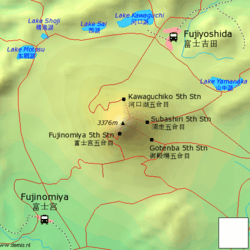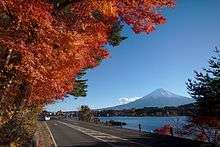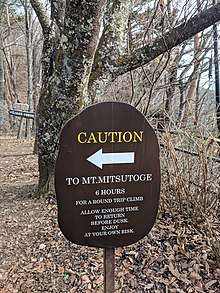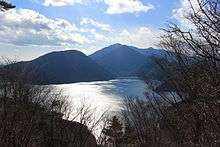Fuji Five Lakes
The Fuji Five Lakes (富士五湖 Fuji-goko) are a group of five small lakes in Yamanashi prefecture, on the North side of Mount Fuji in Japan. From East to West, they are Lake Yamanaka (山中湖), Lake Kawaguchi (河口湖), Lake Sai (西湖), Lake Shoji (精進湖) and Lake Motosu (本栖湖).
Get in

Access to the area usually involves passing through the town of Fuji Yoshida (富士吉田), located between Lakes Kawaguchi and Yamanaka. Fujiyoshida can be reached from Tokyo by taking the JR Chuo line to Otsuki and changing to the Fujikyu line, which passes through Fujiyoshida and terminates at Kawaguchiko. Starting March 16, 2019, there will be regular limited express service between Shinjuku and Kawaguchiko. Weekdays will have two roundtrips daily, while weekends and holidays will have three direct roundtrips. This service will be known as the Fuji Excursion, and trains will be coupled and decoupled to Kaiji services at Otsuki Station.
Highway buses are available from Tokyo to Kawaguchiko and Yamanakako, and at certain times, directly to Kawaguchi Fifth Station (Go-gome) on Mt. Fuji. The bus from Shinjuku station takes approximately 1 hr 45 min and cost ¥1700 in September 2009. Buses are equipped with toilets and luggage compartments, and you get a seat assignment. Buses are also available to and from Tokyo station or Shinjuku station.
Get around
Extensive local bus service is available, particularly in and from Kawaguchiko (Lake Kawaguchi) Station, which is the most popular launching point for exploration of this region or a climb of Mount Fuji. The Kawaguchiko Retro Bus (note the bus and bus stop signs say "Saiko Sightseeing Bus") serves the path around the lake, stopping at many of the local tourist attractions like the museums or parks. A two-day ticket costs ¥1,200 from the bus ticket office inside Kawaguchiko station. A regular local bus serves the five lakes and the caves, also popular tourist attractions.
Bus service is available from Kawaguchiko Station to Kawaguchi Fifth Station, the most popular place from which to start a climb of Mt. Fuji. The bus takes about 50 minutes. Climbing is not recommended outside of official climbing season (July and August) and the buses are restricted to the daytime. This means that if you do intend to climb, you will need to arrange a taxi early in the morning or late at night to get to Fifth Station. In September 2009, a taxi one way cost about ¥13,000.
See
Most visitors come here for views of Mount Fuji, with many postcard shots taken from Lake Kawaguchi in particular.
- 🌍 Aokigahara (青木ヶ原), along Highway 139 (western shore of Lake Sai). Also known as Jukai (樹海) or the "Sea of Trees", this forest is famous for its volcanic caverns and infamous as Japan's top suicide spot — in an average year, over 70 corpses are found.
| Note: Aokigahara is a very dense and scary forest. You can get lost very easily, and there isn't much you can do if you do get lost. Attempts to use a GPS, phone signal, or WiFi will be futile, due to the density of the trees. Do not wander off the trail or into closed off areas. As a summary, as long as you follow proper precautions, you'll be fine. |
- 🌍 Lake Shoji (精進湖). Lake Shoji is a small, horseshoe-shaped lake, idyllic-looking and with pretty views of Fuji. Boating and fishing rental available.
- 🌍 Lake Motosu (本栖湖 Motosuko) (Buses every 30 minutes to an hour). Lake Motosu is the furthest out, also the deepest and clearest lake. Boating rental (paddleboat, rowboat) and a sightseeing boat available. You're not allowed to go out very far if you do rent a boat, though.
- 🌍 View of Mt. Fuji on the ¥1000 bill (千円札の富士山) (Buses run frequently about every hour to half an hour to the visitor center from Kawaguchiko station on the east side of the lake, the spot is an hour walk from there. Bicycles rentals are available at the visitor center. The terrain is fairly flat around the lake. There is a bus that takes you directly to that spot once per day: from Kawaguchiko station, take the bus for Shimobe-onsen (下部温泉) and get off at Kouwansou-mae (浩庵荘前). Take note of the time of the return bus; if you miss it, you will have to make the one-hour walk to the eastern side of the lake to return to Kawaguchiko.). The image of Mt. Fuji on the back of the ¥1000 bill is taken here from the northeast shores of Lake Motosu.
- 🌍 Lake Kawaguchi (河口湖 Kawaguchiko). The easiest to reach and the most touristic of the five; it's also the only one to have an island. There are several views on the Fujisan around the lake. You can see its reflections in the water from the north shores surrounded by cherry blossoms (spring) or lavender field (summer). You can also see the remains of the old lava flows from the Fuji to several places around the lake (in particular on the south shore)
- 🌍 Mount Tenjō ropeway (天上山公園カチカチ山ロープウェイ tenjōyama kōen kachikachiyama rōpuwei) (on the east of the lake). This short cable car climbs to a viewing platform next to mount Tenjō. There you can enjoy a nice view on the lake below and on the mount Fuji, and also have a tea and eat dango (rice flour dumpling).
- 🌍 Kawaguchiko Konohana Museum, 3026-1 Kawaguchi, Fujikawaguchiko-machi, Minami-tsuru-gun (retro bus - Fuji Kyuko line). Mar–Nov: daily 9AM–5PM; Dec–Feb: M-F 10AM–4PM, Sa Su holidays 9AM–5PM. A museum of the popular Japanese children's book "Dayan the Cat" by Ikeda Akiko. Shows a lot of artwork from the artist's books in the world of Wachiworld. Has a lovely giftstore and cafe. Adults ¥500, children ¥300 (discount for groups of over 15 people).
- 🌍 Momiji Corridor (もみじ回廊, Momiji kaitei) (on the north shore, a few minutes walk from the Kawaguchi Konohana Museum heading West). Another celebrated tree-viewing spot. A variety of beautiful trees, including maples and gingkos, line a small river on a gentle slope. The trees are lit up at night during the autumn tree viewing season.
.jpg)
- Itchiku Kubota Art Museum. This small but gorgeous museum on the northeast shore of Lake Kawaguchi was designed by the artist himself. Kubota was Japan's premier modern kimono designer, and this museum houses his incredible series called "Symphony of Light." Well worth seeing. This renowned artist has part of his collection of carefully dyed and worked silk kimonos here, with others showing at galleries around the world. Each kimono is designed to have a picture flowing from one kimono to the next. Museum also has two different tea shops, one Western style, one Japanese style, that make a nice break in the sightseeing day. The grounds of the museum is an artwork in itself with stylised entranceway in the shape of a lone standing doorframe in the forest. Take the Retro Bus, ask the driver to let you off for the Kubota museum. Walk several steps in the direction away from the lake, and you'll see signs. The museum is off to the left in the woods, just another minute's walk, surrounded by beautiful gardens. Adult ¥1300.
- 🌍 Momiji Tunnel (紅葉トンネル, Momiji tonneru) (on the north shore; on foot, from the last stop of the Retro Bus, walk (carefully) to the west along the road (no side-walk)). In autumn, the beautiful orange and yellow tones of changing leaves ("momiji") are beautiful, and there is also a nice view on the lake and the mount Fuji.

Do
There are no real beaches, and no swimming is allowed in any of the five lakes. Paddleboats and rowboats are available for rental at most, and fishing equipment at some.
- Fuji-Q Highland. One of Japan's largest amusement parks and home to Fujiyama (1996), briefly the world's tallest rollercoaster, and Dodonpa (2001), briefly the world's fastest.
- Ensoleille sightseeing boat. This boat runs frequent 20-minute sightseeing rides on Lake Kawaguchi during the day. A bit pricey for such a short ride, but the views of Fuji are excellent, and it's a good chance to see more of the lake. Tickets can be bought from the machine near the boat dock -- attendant will also be around to answer questions. Adult ¥950.

- 🌍 Hike to Mt. Mitsutsoge (Take the Mount Tenjō ropeway to the top). The hiking time is 3 hours there and 3 hours back. The path is fairly well maintained.
Buy
Eat
Fujiyoshida is famous for its udon noodles.
Drink
Sleep

- Kawaguchiko Station Inn. Small inn/hostel directly across from the train station, very convenient location. Single rooms available. Clean, friendly place with shared bathrooms on each floor, free internet, showers/laundry/Japanese baths on top floor, small restaurant.
- Fuji Lake Hotel. Guests can enjoy the view of Mt. Fuji from both room and bathroom. The chartered barrier-free open-air baths are also popular.
- Kozantei Ubuya. A high class Japanese-style inn with views of Mt.Fuji and Kawaguchiko from both the bedrooms and the large bathrooms. The bathrooms also feature an open-air bath.
- Kasuitei-Ooya. Kasuitei Ooya is contemporary Japanese style inn standing just on the shore of Lake Kawaguchi. It has renovated rooms with private open-air bath and observation bathroom. Guests can enjoy more hot springs than ever before.
- Fuji-View Hotel. The Fuji View Hotel stands just on the shore of Lake Kawaguchi. Guests can appreciate natural beauties including the garden in the hotel property. The garden accommodates gorgeous view of blossoms of over 300 cherry trees in over 99,000 m².
- Shuhokaku Kogetsu. This hotel is near Kawaguchiko and All rooms and hot springs have a magnificent view of Mt. Fuji. Guests can enjoy the beautiful Mt. Fuji changing its feature from season to season.
- Fuji Royal Hotel Kawaguchiko. The most reasonable hostel with hot spring in Kawaguchiko area.
- Fujiyoshida City Hotel, 2 Chome-7-12 Matsuyama, Fujiyoshida (200 meters north-west of train station), ☎ +81 555-24-3300. Simple hotel, clean rooms, very close to the Fujiyoshida train station. Some rooms have a Mt. Fuji view. Free Wi-Fi. Breakfast (self-serve) must be pre-ordered the night before, costs ¥300 and consists of bread, coffee, tea, jams and one hard-boiled egg per person. ¥6000 for one night, double room.
Connect
Go next
| Routes through Fuji Five Lakes |
| Otsuki ← | N |
→ END |
| into |
N |
→ END |
| END ← | N |
→ Gotemba → Hakone |
| Okutama ← Otsuki ← | N |
→ Fujinomiya → Fuji |
| END ← | N |
→ Minobu |
| END ← | W |
→ Doshi → Sagamihara |